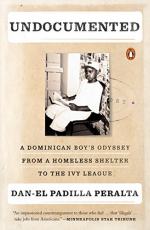|
This section contains 709 words (approx. 2 pages at 400 words per page) |

|
Undocumented Summary & Study Guide Description
Undocumented Summary & Study Guide includes comprehensive information and analysis to help you understand the book. This study guide contains the following sections:
This detailed literature summary also contains Topics for Discussion on Undocumented by Dan-el Padilla Peralta.
The following version of this book was used to create this study guide: Padilla Peralta, Dan-El. Undocumented. Penguin Press. First Edition, 2015. The book’s first-person narrative focuses on the author’s experiences growing up and seeking both education and employment as an undocumented immigrant in the United States of America.
The book begins with a Prologue, in which author Peralta first describes an experience he had while in high school that illustrates how challenging it was for him to move between the two very different sides of his life – that is, attending an expensive private school while living in poverty with his immigrant family. In the latter part of the Prologue, Peralta explains that part of his intention in writing the book was to claim both these aspects of his identity, as well as other aspects of himself that he experienced as being at odds with each other while he was growing up.
The narrative then moves into the first of its three parts. In “Childhood,” Peralta describes how he and his family arrived in America from the Dominican Republic and made their home in New York, where his Mom already had family and where she gave birth to his younger brother, Yando. After Yando’s birth, the family tried to make a life together in America but, Peralta writes, his father became increasingly restless, and eventually moved back home, leaving Peralta’s mother to raise two sons on her own. After struggling for some time to make ends meet, Peralta says, the family was forced to move into a homeless shelter where they stayed for several months. They eventually moved into an apartment, all the while Peralta developing a love for both books and learning, particularly for Classical literature. There are descriptions of his early years at school, the family’s ongoing struggles to avoid being exposed as undocumented immigrants, and the challenges they faced while trying to sustain themselves on minimal income.
In Part 2, “Boyhood,” Peralta describes how early academic success and connections with caring mentor figures enabled him to receive a scholarship to attend the expensive Collegiate School. While there, he made important friendships, deepened his interest in Classical literature, and found a succession of highly placed allies in administration that helped him achieve his academic goals. At the same time, he was developing friendships with his fellow altar boys at his family’s Catholic church. At one point, he says, he went along with the gang on a shoplifting expedition that went wrong, and ended up getting caught. It was only with the help of the church’s priest, Father Michael, that he escaped both a fine and the humiliation of telling his mother. As his school years continued, Peralta writes, it seemed to become inevitable that he was going to attend college. He and his family were still undocumented, which presented significant financial and legal obstacles to his plans, but with the help of his teachers and mentors, he was accepted at Princeton University.
Part 3, “Youth,” focuses on Peralta’s experiences at Princeton and beyond. As he portrays those years, he describes how he managed significant academic achievement, developed a circle of friends, and remained able to keep his immigration status secret. However, when it started to become clear that he could be on track for graduate studies, his immigration statues once again became an issue, to the point that he felt compelled to come out publicly as undocumented. This choice, in turn, led to further complications in his plans to undertake graduate studies in England, complications that included a potential ten-year ban on returning. Peralta chose to continue his studies, in the hope that he and his allies could find a way to get the ban overturned. Eventually, they succeeded, and Peralta was able to return first on a work visa, and then as a doctoral student at Stanford University.
The book concludes with an Epilogue in which Peralta issues a call to the government of the United States and to the undocumented immigrants who live there. He urges them to take a stand in support of all undocumented immigrants, and work towards giving them the freedom and opportunity to pursue the American Dream that they came to America to find.
Read more from the Study Guide
|
This section contains 709 words (approx. 2 pages at 400 words per page) |

|



